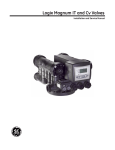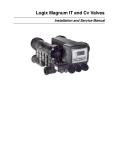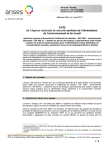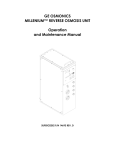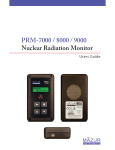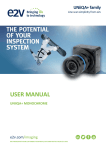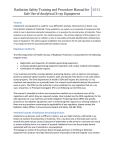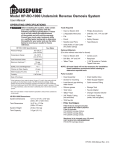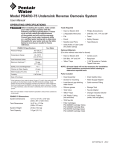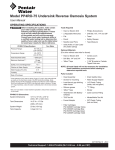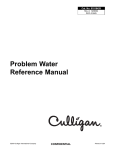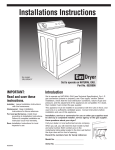Download Residential Water Treatment— When it Absolutely Has to Work!
Transcript
Spotlight Residential Water Treatment— When it Absolutely Has to Work! T By C. F. ‘Chubb’ Michaud, CWS-VI of crystal clear ice cubes and great tasting he following are some standard water. Can we live without these devices? perceptions and questions often Yes we can. asked by consumers relative to These are enhancement devices. They add convenience residential water treatment system safety. Long-time industry and comfort. If they don’t work properly will they cause harm? expert Chubb Michaud supplies some answers and insights. Probably not. Many people live long and happy lives without them. Municipal water is generally safe. Simple home water treatment devices using ion exchange It is the responsibility of every municipal water supplier technologies are often called upon to do more than soften or deto send out water of a quality that meets the minimum US EPA alkalize the incoming water. Cation exchangers not only remove standards for maximum contaminant levels (MCLs). Municipal hardness but can also be used to reduce sodium (when using treatment plants do a fine job, but are they 100 percent efficient potassium as regenerant), heavy metals, radium, aluminum, iron, 100 percent of the time? manganese and ammonium ions. No they are not. Try as they may, city water suppliers have Salt-regenerated anion units can reduce alkalinity, sulfates, little control over water quality once it leaves their plant. uranium, arsenic, chrome, nitrate, perchlorate and, in some cases, These days, it seems to be a quantity issue rather than a even fluorides. It is unlikely that any of these contaminants will quality issue. People are more upset when their supplies dry up exceed the MCL if supplied via municipal water but if you have and get cut back than if the taste, odor, color or chemical content a well supply, you are on your own! drifts a little out of range. ’Safe’ water is a relative term. Ten years ago, 50 ppb of arsenic in your city-supplied water was considered safe. Now we know They are built the same way, but are they the it was not and the new standard is 10 ppb. same? Is that level 100 percent safe? No, it is not, but the numbers The obvious difference between a water enhancement device, of users who might be affected by consuming arsenic at these such as a softener or a dealkalizer when they are used to remove levels is considerably lower. a health threat, is in the degree of reliability in making sure that Contaminants regulated by the US EPA are really unsafe threat is removed. They absolutely have to work! at any level other than zero. While the masses of consumers are For these types of customers, it is critical to impress upon tolerant of these contaminants in their lifetime, there are always them their level of responsibility as owners of the equipment. super-sensitive individuals who should take special precautions This may require specific cross training and education to maintain if they experience unexplained allergies or reactions to traces of optimum performance. chlorine, ammonia, fluoride, metals, pH and alkalinity. Even Much has been written about multi-tasking—using your water meeting all standards can still cause issues for these water treatment device for more than its face value. But nothing sensitive individuals. has been written about making sure that device is equipped with the safeguards to ensure that it actually works. Is there something there that will tell you it is not working? Who is responsible for supplying ‘safe’ water to How often should the homeowner check or test the system? your family? What is the implied role of the supplier in these instances? A Water composition may undergo changes when being water filter installed to correct a health threat is not a ‘set it and transported to your tap. Pipe leaks occur. Floodwaters back up. forget it’ type of sale. Sewage pipes break. Things leak in as well as out. Today’s electronic control valves, such as those used on High levels of chlorine help protect the water from bacterial softeners, are very reliable. Once they are set up, they do their job contamination, but if you fill your fish tank with this ‘safe’ water, day after day with little maintenance or even user attention. the fish die. The Creator gave us a sense of taste and smell for However, they were not intended for critical applications all a reason. If it doesn’t smell right and doesn’t taste right, maybe by themselves. What could possibly go wrong? Some questions it isn’t right. are posed that might be raised directly by a customer in need of The responsible city is in charge of supplying good water. a reliable treatment device. Make sure you have the answers. However, it is the absolute responsibility of the user to make sure it is safe for his family needs. Much of the treatment and conditioning industry is occupied What if we lose power? Does the system reset with improving the aesthetics of water used in the home. There itself? is no doubt that color, taste and odor can be greatly improved Older time clock systems may simply reset to 12:00 midnight with the use of a granular activated carbon (GAC) filter. A and continue on their way. This means that they may regenerate water softener can make housecleaning chores more tolerable in the middle of the day and not supply treated water during by eliminating scale build up, soap scum, toilet bowl rings and periods of family use. scratchy towels and bed linens. New systems may have a battery backup, but even then they Under-the-sink reverse osmosis (RO) can give us the luxury only last a day or so. For critical applications (those treating health Water Conditioning & Purification January 2010 threats), the user must be reminded to check and reset his filter time clock after a power outage. Not all users walk past their filter on a daily basis. So make the effort to check. Again, customer education and responsibility must be reiterated to avoid unnecessary service charges. What if we lose power in the middle of a regeneration cycle? What happens? If the power fails in the middle of a regeneration cycle, the control valve will remain in that position until the power resumes. It will then complete the cycle itself and return to service. If you are on a well, the power outage may or may not affect the well pump, depending upon the cause. If the well pump is also shut down, the system will simply drain the pressure tank. If a storage tank is used to feed the system by gravity, it will continue to run in the ‘stuck’ position until the power returns. If the outage occurred after the brine cycle was completed, the system will likely exhaust itself and not offer protection until after the next regeneration cycle. How will I know if the system hasn’t properly regenerated? In all likelihood, users will not know if their systems have not properly regenerated. They must be reminded to check salt levels to make sure salt is being consumed. A salt sensor in the brine tank is a safeguard. Some of the newer valves can be equipped with sensors inside the resin tank that will alarm if the properties of the water do not change after regeneration. If used, make sure the customer will notice the alarm. Is there any possibility that if the unit does not regenerate it will slough contaminants? This is a real possibility, but that will depend on water composition, what is being treated and how it is being treated. For highly selective species such as radium and uranium, there is little likelihood of sloughing. For arsenic and nitrates, it can happen. How will I know if I am out of salt? Users must be reminded to check their brine tank and add salt as needed. Salt monitors can be used here, but may not get the message through if the system is in a remote part of the garage or basement. The unit failing and not offering an audible alarm is also problematic. Do we need special approval or inspections to use this system? Depending on where you work and where your customer lives, you may need some sort of certification to install a device that is offered for treating a health threat. Most of the time it can be done without certification and without special permit or inspection. Everybody involved with the system, from design to installation and operation, must take part in making sure the system works! If we use a large amount of water because we have extra company, how does the system know and what will it do to make sure we don’t run out of safe water? All systems are equipped with a reserve function that provides a cushion of sorts. ‘Smart’ valves will review the usage over a recent period of time and adjust brining according to need. The user, nonetheless, may face the occasional day where the system is not offering adequate protection. No reserve system is guaranteed. Water Conditioning & Purification Is there anything that can foul the system or cause it to stop working? Fouling is a real possibility, particularly if it is an anion system operating in high-hardness feed water without a softener. Periodic testing is necessary to make sure the system is continuing to perform to specification. We have seasonal changes in our well water. How does the system know and adjust? It doesn’t. This is part of the system monitoring and testing that has to be initiated by the user. How often should I have my water tested? Depending upon what has to be treated, it may be quarterly. How do I sample my water and to whom do I send it to for testing? The company or installer putting in the system should leave instructions for doing this. How often do you come by to test my system to make sure it is still working? Most companies do not schedule a regular service call to do this. However, it does provide opportunities for further work and future sales. If you are not available, who should I call? Make sure there is a service manual left with the user that gives alternative contact numbers for emergency contact and service. How often should I have my system tested so I know when to replace the resin? Arrange to have the water tested every three to six months. Ask your resin provider about the expected life of the system and include that with your sales contract so there will not be unexpected costs. This also lets the new owners know what is to be expected. Resins used in critical applications should be tested after three years and then annually thereafter. Should a home change hands, a follow-up call should be made to acquaint the new owner with critical issues for operation and safety of the system. Should I have some kind of backup system just in case? For critical applications such as high arsenic, this is a must. The backup may be a completely redundant unit with a different regeneration schedule or you may make a small, under-the-sink reverse osmosis system part of the initial package. When you accept the order, you accept the responsibility! A potential customer in search of a treatment device to cure a critical need is not simply another opportunity to make a buck. Critical applications require special skills in design and installation and a thorough knowledge of treatment options. Simply oversizing the system does not guarantee it will work. Critical applications refer to those water treatment needs where serious consequences to human health are at stake if the water is left untreated. The US EPA and other world regulatory agencies have established guidelines for maximum contaminant levels (MCLs) that are safe to consume in drinking water. For any given contaminant, the MCL is simply the highest level of that contaminant that is allowed in drinking water. January 2010 It is based on a statistical probability that if a population of 100,000 consumers drank two liters of that water every day for 70 years, only one in 100,000 would get sick. It also takes into account costs, which represent safety at a price (if you are willing to pay more, the US EPA can make it even safer). The primary standards (National Primary Drinking Water Regulations, or NPDWRs) are legally enforceable standards that apply to public water systems for the protection of public health. Also listed is the MCLG or maximum contamination level goal. This is actually what US EPA thinks the level should be if cost were no object. Secondary standards are non-enforceable guidelines regulating contaminants that may cause cosmetic effects (such as skin or tooth discoloration) in drinking water or aesthetic effects (such as taste and odor or color). US EPA recommends these standards but does not require systems to comply (remember who is ultimately responsible for drinking water safety). However, individual states may choose to adopt these as enforceable standards. What are the specific inorganic chemicals that fall on the US EPA primary list, with health effects and limits? MCL MCLG Contaminant (mg/L) (mg/L) Antimony 0.006 0.006 Arsenic 0.010 0 Asbestos 7 x 106 same fibers/L Barium 2 2 Beryllium 0.004 0.004 Cadmium 0.005 0.005 Chromium 0.1 0.1 Copper 1.3 1.3 (action level) Cyanide 0.2 0.2 Fluoride 4.0 4.0 Lead 0.015 0 (action level) Mercury 0.002 0.002 Nitrate-N 10 10 Nitrite-N 1 1 Selenium 0.05 0.05 Thallium 0.002 0.0005 Alpha particles 15 pCi/L 0 Beta particles 4 millirems/yr 0 Radium 226/228 5 pCi/L 0 Uranium 30 ug/L 0 Health effects from ingestion of water increases blood cholesterol skin damage, circulatory problems, cancer intestinal polyps increases blood pressure intestinal lesions kidney damage allergic dermatitis (total Cr) gastrointestinal distress, liver damage nerve damage, thyroid problems bone disease, mottled teeth mental retardation, kidney damage kidney damage blue-baby syndrome, shortness of breath blue-baby syndrome, shortness of breath circulatory problems, hair loss loss hair loss, kidney, liver problems increased risk of cancer increased risk of cancer increased risk of cancer risk of cancer, kidney toxicity What are the inorganic chemicals that fall on the US EPA secondary list, with limits? Contaminant Aluminum Chloride Secondary standard limits 0.05 to 2.0 mg/L 250 mg/L Water Conditioning & Purification Color 15 color units Copper 1.0 mg/L Fluoride 2.0 mg/L Iron 0.3 mg/L Manganese 0.05 mg/L pH 6.5 to 8.5 Silver 0.10 mg/L Sulfate 250 mg/L TDS 500 mg/L Zinc 5 mg/L (For a review of the complete list of organic and inorganic contaminants, please visit US EPA’s website, www.epa.gov/ OGWDW/mcl.html.) How dangerous are some of these contaminants? The US EPA MCL levels take into account that contact with the contaminant will be a long-term exposure and they don’t always speciate. Organic forms of arsenic, for example, have lower toxicity than inorganic forms. Trivalent (As+3) is more toxic than is pentavalent (As+5). Most arsenic poisonings are not caused by elemental arsenic but by arsenic compounds. Arsenic trioxide (As2O3), for example, is 500 times more toxic than is elemental arsenic. According to R.C. Dart’s report in Medical Toxicology (2004) (Williams & Wilkins, pp 1393-1401), it takes approximately one mg/Kg/day for acute toxicity. So, if a 175-pound person (80 Kgs) consumed 80 mg of arsenic in water (about 1,000 liters of 80 ppb As+5) in 24 hours, it would be considered a lethal dose. (Note: if a 175-pound man drank 1,000 liters of anything in 24 hours, it would be lethal as well!). Others report numbers about 40 percent less. However, detrimental effects of arsenic are reported with as little as 0.0003 mg/Kg/day, so for our 175-pound subject, that’s only one liter of 24 ppb laced water per day. We can see why the old limit of 50 ppb was considered non-protective. Ingested arsenic can replace phosphorous in the bone structure and remain in the body for years. This explains the long-term effects of low-level exposure over many years. In reality, no level of arsenic in water is safe. Arsenic was selected to illustrate both an opportunity as well as an obligation. Arsenic is ubiquitous. It is everywhere and just about any water source may contain two to three ppb. We have the technology to remove it, but we have to do it right. Is there a philosophical approach to critical water treatment? The same designed and sized piece of equipment can be sold to remedy an 11 ppb arsenic problem as was sold to remedy an 11 ppm problem. The difference is with 11 ppm, you are only about six to eight liters of water away from a sure death. In treating truly critical water, there is more partnering between design engineer, OEM fabricator, dealer, installer and user. These systems really have to work. As outlined earlier, many things can go wrong with critical systems that are not that big of a concern with aesthetic treatment systems, even though they are basically the same piece of equipment. The differences lie in the consequences of failure and the subsequent degree of reliability needed to offer a protective device. Critical systems are not designed to operate at 10 gpm/cubic foot of media. A better approach is two to three gpm/cubic foot. This gives more reserve and maximizes the capacity. January 2010 A typical household will generally only use water at about 2.5 gpm with an occasional spike to five gpm, so a one-cubicfoot system is still viable. With critical systems, we do not rate at ‘book’ capacity the way one usually rates a softener. We use a conservative engineering factor of 70 to 80 percent. This means that an oversized system is increased by 25 to 30 percent to start. An under-bedding is used to maximize the media capacity, with an electronic valve and meter also utilized. The reserve is set for one full day’s use of water. When the situation dictates, a duplicate system in series is installed. A service manual is written telling exactly how the system works and what the maintenance requirements are and where the responsibility lies. Emergency phone numbers are included, as are contact names. The customer is instructed as to what their obligation is in maintaining the system integrity and reliability. Spending time with the customer one-on-one is necessary to instruct them on the system operation and to answer questions. Follow-up calls are scheduled to have the water tested periodically. A refrigerator magnet or calendar is often included that serves as a reminder to check the salt level at least once a week and pay attention to alarms. Instructions are also provided on what to do if the power is lost or if the customer believes he has some other problems. A backup system, such as an under-the-sink RO, is also offered for drinking water use. All of this is installed due to the obligation (provided when the job is accepted) to protect the consumer. What might the ideal system provide? Ideally, a critical application residential system would be able to do a self diagnosis when something goes wrong and alert the user to it. The best alert would be for the control valve to restrict Water Conditioning & Purification (not shut off) the water flow as a tip-off to check the controls. The controls would indicate the possible problem on a display and the manual would give the remedy. For instance, ‘check brine tank’ might indicate the system did not regenerate properly and might be out of salt. Or, the system would tell the user ‘add salt’ if it had a salt level sensor. It might indicate ‘restart system’ or ‘adjust time’ if the power failed and the system needed resetting. It could call for an additional regeneration or it might simply say ‘call technician’ if it couldn’t diagnose the problem. The display could also alert the user to have the water, the system or the resin tested with a pre-programmed calendar. The key is to have the controller make it known to the user that action has to take place. There is no current device (or devices) that can automate all of this right off the shelf. This presents constant new opportunities for the future. References 1. http://www.epa.gov/safewater/contaminants/index.html#primary 2. C.F. Michaud. Industrial Water Treatment, WC&P, February 2009 About the author S C.F. ‘Chubb’ Michaud is CEO and Technical Director of Systematix Company, Buena Park, CA, which he founded in 1982. An active member of the Water Quality Association, Michaud has been a member of its Board and of the Board of Governors and past Chair of the Commercial/ Industrial Section. He is a Certified Water Specialist Level VI, serves on the Board of Directors of the Pacific WQA (since 2001) and chairs its Technical Committee. A founding member of WC&P’s Technical Review Committee, Michaud has authored or presented over 100 technical publications and papers. He can be reached at Systematix Inc., 6902 Aragon Circle, Buena Park CA 90620; telephone (714) 522-5453 or via email at [email protected]. January 2010





